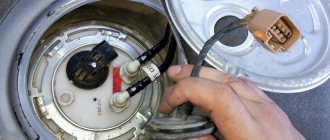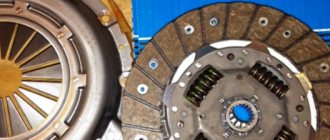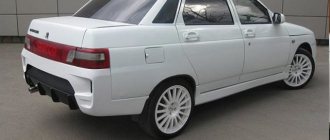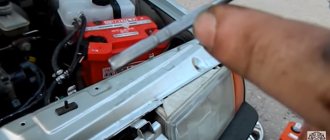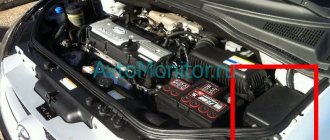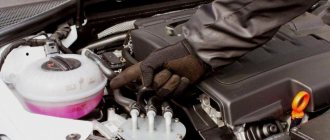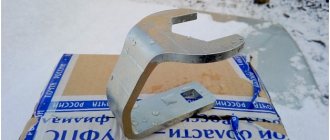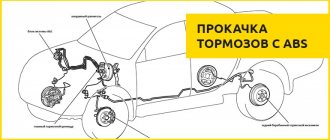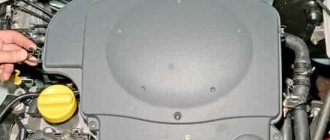It is necessary to replace the coolant on the Lacetti for further operation of the vehicle. This procedure should be carried out every 40-50 thousand km. mileage or for example every two years. In general, the coolant is filled from the factory for a period of 5 years or a mileage of up to 200,000 km.
Car manufacturers recommend that you take special care when replacing coolant (coolant), since the operation of the engine cooling system depends on its quality. What, in the worst case, can cause engine overheating on a Chevrolet Lacetti
How to change antifreeze on a Chevrolet Lacetti?
Antifreeze (coolant), like other fluids in a car, must be changed on time. Automakers advise replacing it every 40-50 thousand kilometers, as a result of which engine overheating will be completely eliminated. Experts who work at a service station recommend changing the refrigerant at least once a year, otherwise rust may appear. How to drain antifreeze from a Chevrolet Lacetti and fill in new one after flushing the system will be discussed in this article.
The coolant is needed not only to cool the engine, it is also necessary to lubricate the coolant pump, which occurs due to the components that are in the antifreeze. In addition, the brands of antifreeze produced today contain special substances that counteract the appearance of scale and prevent the formation of deposits. But it should be noted that these chemical substances have a relatively short duration of action.
What kind of coolant is used
The cooling system of a Lacetti hatchback is operated together with high-quality antifreeze made from ethylene glycol. It is better to pour it into the expansion tank. Silicate is the main element in antifreeze, which is designed to serve as protection against rust.
Antifreeze is sold in concentrated form. If the old one is still flooded, then it should be removed from the tank. For this reason, before using the concentrate, add purified water in a 1:1 ratio. At low temperatures of −40 degrees and below, the liquid must be poured in a ratio of 3:2.
Replacement frequency, what antifreeze to fill
The frequency of replacing antifreeze in a new car is regulated in the maintenance card. As for used cars, replacement should be carried out based on the recommendations of the coolant manufacturer.
For example, if you use original GM Dex-Cool Longlife coolant in a Chevrolet Lacetti, then replacement should be done every five years. This is exactly the period stated by the manufacturer, and also guarantees the preservation of all properties.
The original product is available in the form of a concentrate; its complete analogue is Havoline XLC. You can also use an analogue in the form of a finished product Coolstream Premium, produced at the Russian enterprise TECHNOFORM.
You can also pay attention to other manufacturers, for example, FELIX Carbox antifreeze has won good trust among car enthusiasts. The main thing to remember is that the color is just a dye, and the liquid must be selected according to tolerances. If the fluid has GM approval, then it can be used in the cooling system of this vehicle.
How much antifreeze is in the cooling system, volume table
| Model | Engine capacity | How many liters of antifreeze are in the system | Original liquid / analogues |
| Chevrolet Lacetti | gasoline 1.4 | 7.2 | Genuine General Motors Dex-Cool Longlife |
| gasoline 1.6 | Havoline XLC | ||
| gasoline 1.8 | 7.4 | Coolstream Premium | |
| gasoline 2.0 | FELIX Carbox |
Replacement frequency
The service life of antifreeze until it needs to be replaced, according to the manual, is from 5 to 7 years, depending on the type of coolant. Most often, car owners encounter unscheduled replacements due to the addition of low-quality corrosion inhibitors to the coolant. As a result, the antifreeze takes on a rusty color a couple of days after being poured into the circuit. It is strictly forbidden to delay replacing such a coolant, as irreversible damage to the walls of the radiator and cylinder block occurs. Also, unscheduled fluid replacement may be required for the following reasons:
- Liquid leaves the system as it flows through all seals and seals. This is due to the wrong choice of coolant. Its viscosity is lower than required.
- Excessive gas formation occurs in the circuit, despite the fact that the temperature of the power plant is within normal limits.
- Antifreeze gives off an unpleasant odor. In some cases, it even penetrates into the interior.
- Engine oil or other technical fluid has entered the coolant.
- Mixing of two types of antifreeze occurred, for example, as a result of emergency topping up.
- There was a persistent smell of burnt rubber.
How to prepare antifreeze
It is best to use coolant concentrate. The fact is that after flushing the circulation circuit, a certain volume of distillate remained in the engine, about 1.5-2 liters. If you pour fully prepared antifreeze into the cooling system, the distilled water remaining in the engine will noticeably dilute the prepared antifreeze, worsening its performance characteristics.
Regarding concentrated antifreeze, this type of coolant must be diluted with distilled water. This is what is needed in this case.
As a rule, the optimal proportions for preparing antifreeze are indicated on the label of the canister with the concentrate. Most often, concentrated coolant must be diluted with water at a ratio of 1:1 . If the antifreeze is changed to a Chevrolet Lacetti with a 1.4-1.6 engine, where the capacity of the circulation circuit is 7.2 (l), then in this case you will need 3.6 (l) of distilled water and 3.6 (l) of coolant concentrate. From the volume of water, it is necessary to subtract the volume of distillate that remains in the engine after flushing.
If during flushing the coolant circuit, 5.2 (l) came out, this means that exactly 2 (l) of distilled water remains in the engine.
Preparing antifreeze. In a clean plastic container, mix 1.6 liters of distilled water and 3.6 liters of concentrate. Pour the resulting coolant mixture into the expansion tank. The concentration of fresh antifreeze will be increased, but it will quickly return to normal when the 2 liters of distillate remaining after washing are added to it.
Required tools and materials
In order to change the coolant on a Chevrolet Lacetti, you will need the tools listed in the table below.
| Tools and materials | Note |
| Screwdriver | Flat blade |
| Coolant drain container | Volume up to 9 liters |
| Distilled water | Required for diluting concentrated antifreeze. |
| When changing the type of antifreeze, you must first flush the circuit with distilled water. This will require a liquid volume of 7 to 13 liters. | |
| Pliers | Can be replaced with pliers |
| Rubber tube | Diameter 10 mm |
How to change the coolant?
When replacing the refrigerant yourself in a Chevrolet Lacetti, follow the temperature standards. Do not change the fluid at air temperatures above +40 degrees Celsius. Otherwise, the risk of skin burns increases.
As we see in the photo, pouring antifreeze into the Lacetti hatchback is very easy. Below we will describe in more detail how this procedure is carried out.
Tools, accessories, consumables
There are a number of devices and materials that are required for use when carrying out the procedure for replacing antifreeze fluid.
For this process you need:
- concentrated cooling liquid or already diluted mixture;
- screwdriver;
- purified water;
- container for used coolant;
- it is advisable to use a rubber hose with a diameter of about ten millimeters;
- a platform or inspection hole will obviously not be superfluous for such work.
How to drain antifreeze?
Draining antifreeze for cars of all brands, including the Chevrolet Lacetti, looks the same. First, we need a container with a capacity of ten liters. For the 7.2 maximum liters of the Lacetti, this capacity will be just right. Also find a wrench for 13. It is better to take a socket or socket type wrench, as their operation is much simpler. The engine protection will need to be removed if equipped.
The design of the car requires two drain holes: the first is located in the engine block, and the second is in the radiator, on its lower part.
The initial stage is to place a pre-prepared container near the drain hole, which is located on the radiator. If necessary, cover part of the generator with ordinary household film. Be sure to check the engine temperature before the procedure: it must be cool. We unscrew the plug in the engine block using the thirteenth key and begin the process of draining the antifreeze.
There are several important nuances in the process. Do not forget that the stove is connected to the cooling system. This means that it is worth opening it as much as possible when draining in order to get rid of the waste liquid in full.
Apply one more trick - install the car so that the lower part is higher than the front. This technique perfectly promotes the drainage of antifreeze through the radiator hole. By the way, in this position, liquid flows to the main hole even from the stove. Do the same steps when adding refrigerant. The only difference is that the machine must be in exactly the opposite position. Then the antifreeze will fill the radiator.
How to flush the system?
To clean the cooling system from residual waste antifreeze, purchase a special flushing liquid at any store. Pour it into the expansion tank.
After this, start the engine and give it time to warm up. Wait until the temperature is normal for operation. Be sure to get rid of any air bubbles by turning the stove on at full power. When the engine is warmed up, turn it off and wait until it cools down.
We get rid of the flushing liquid by draining.
How to fill?
There are only a few final steps left to complete:
- When the engine is completely clean, we proceed to filling with fresh refrigerant. Again, if the antifreeze is concentrated, dilute it; if it is a ready-made solution, fill it in immediately. Fill the expansion tank with the required amount of antifreeze.
- The plug must be screwed in.
- We monitor the flow of excess liquid mixture.
- Let the engine run for a while until it warms up.
- Turn off and wait until it cools down completely.
Leaks and problems
When replacing the coolant, you should inspect all pipes and connections for possible problems. After all, when the water is drained, it is easier to change them than to tear them during use. It is necessary to pay increased attention to the clamps; for some reason, many people install ordinary worm clamps. Over time, they compress the hoses, causing them to break.
In general, the Chevrolet Niva has several main problems related to the cooling system. It often happens that antifreeze leaves the expansion tank. The plastic on it constantly bursts, which causes leaks. In this case, a replacement will be necessary.
Another problem is the antifreeze under the driver's mat, which can cause a sweetish smell in the cabin and also fog up the windows. Most likely the culprit will be a leaking heater radiator. This dilemma is usually described as a chef's nightmare.
READ How many Liters Tank VAZ 2110
There is also a situation where antifreeze is thrown out of the expansion tank. This may indicate a broken cylinder head gasket. This is checked as follows. When the car has completely cooled down, remove the expansion tank cap, after which you need to start the engine and actively rev it up. It is better to have a second person with all this so that he can see whether the antifreeze in the tank will boil at this time.
How to fill?
There are only a few final steps left to complete:
- When the engine is completely clean, we move on to filling in the freshest refrigerant. Again, if we dilute concentrated antifreeze, if we fill the prepared solution immediately. Fill the expansion tank with the required amount of antifreeze.
- The plug needs to be screwed in.
- We watch for the flow of excess watery consistency.
- Let the engine run a little until it warms up.
- Turn off and wait until it cools down completely.
Step-by-step guide to replacing antifreeze (coolant) in a Chevrolet Lacetti
In addition, antifreezes produced today include special substances that counteract the appearance of scale and prevent the formation of deposits.
Just not by much, otherwise it might fly out under the pressure of the liquid! Use a screwdriver to unscrew the cooling system radiator drain valve a few turns. Use a slotted screwdriver to unscrew the cooling system radiator drain valve a few turns 4. Now open the tank filler cap again. After this, waste liquid should begin to flow out of the drain fitting. It will take a long time to leak, so you can take a break for now: Wait until the liquid stops flowing.
As you know, all the fluid from the Lacetti engine is not drained. There may be up to two liters of old fluid left there!
Replacing coolant in a Chevrolet Lacetti - step-by-step instructions
In this article I will talk about how to replace antifreeze on a Chevrolet Lacetti with your own hands, that is, in a home garage. The replacement of coolant in the Lacetti cooling system is regulated by the manufacturer after every thousand km.
Before proceeding with the replacement, I note that after completely draining the antifreeze, about 2 liters of old coolant remain in the cooling system, despite the fact that the total volume of antifreeze is 7.4 liters. In this regard, most service stations recommend flushing the cooling system when replacing antifreeze.
But it is fundamentally wrong. It is worth remembering that the color of the coolant does not affect the technical qualities in any way. The opinion described above has taken root in the public consciousness due to the marketing moves of companies.
Companies want their product to be different from similar products on the market made by competitors. Today you will find antifreeze in various colors on sale: However, by the color of the liquid you can determine the composition and dyes added to the mixture.
Recommended reading
The toxic neon tint of some of these products is a sign of the addition of an additive with fluorescent properties. It plays an important role in finding antifreeze leaks. By illuminating the space under the hood with ultraviolet light, the technician can easily determine the causes of the breakdown.
The service life is approximately five years or thousand. It is the shade of the liquid that will help you distinguish the desired antifreeze with an increased service life from others. How often should antifreeze be changed?
Sherole Lacetti How to modify the cooling system
There are a number of recommendations regarding the issue of changing the refrigerant. The coolant should be changed every two years or every thousand kilometers that the car has driven. The time for replacing antifreeze is determined based on the following characteristics: Fluids with silicate additives are changed once a year.
Recent Entries
The density of a normal solution is 1.gcm3, taking into account a temperature not higher than 20 degrees Celsius. The refrigerant that was in use has a completely different density. The appearance of neoplasms in non-liquid form. Indicators of antifreeze performance are the presence of all kinds of solid sediments, foam, and scale fragments.
Sometimes a mass of mushy consistency appears on the inner walls of the expansion tank. If the above symptoms are detected, be sure to replace the refrigerant. The bright color of the antifreeze begins to fade during operation, becoming faded, heterogeneous and cloudy. You should stop using the liquid if it has acquired a reddish or reddish tint, since dissolved corrosion is present in the solution.
Specialists working at service stations advise carrying out this procedure once a year; this measure will prevent the appearance of rust. A step-by-step guide to replacing antifreeze coolant in a Chevrolet Lacetti. The procedure for replacing coolant should be carried out in a remote place, away from animals and children.
Do not neglect the safety of others, as the coolant is quite toxic. It is strictly forbidden to discharge refrigerant into rivers or reservoirs, as this can cause damage to nature and the environment.
Replacing coolant in a Chevrolet Lacetti - step-by-step instructions
If old and new fluid are mixed, the anti-corrosion characteristics are significantly reduced. The duration of action of the anti-corrosion liquid significantly depends on the various anti-corrosion elements contained in it.
As long as they are in the required amount of antifreeze, there is no need for replacement. When their quantity decreases, the risk of so-called electrolytic corrosion of the car engine and radiator increases.
As a result, it is better not to delay replacing the coolant, carrying out this procedure in accordance with the regulations.
Volume and color of coolant on Lacetti
The volume of the cooling system is 7.2 liters for 1.4 and 1.6 liter engines. For 1.8, the volume of the cooling system is 7.5 liters. The coolant used in the cooling system is ethylene glycol-based antifreeze The GM manufacturer fills in red , marked “G12,” for all types of engines and lacetti car bodies. It is designed for a service life of 5 years, or a mileage of 200,000 kilometers.
Air has entered the cooling system, what should I do?
Air enters the system due to depressurization of the external pipes or failure of the clamp fixing fitting. The new software has adjusted calibrations for winter engine starting. Checking the operation of the ignition system and checking the operation of peripheral sensors will show where exactly the air entered the system.
If air entered the Chevrolet cooling system when replacing antifreeze in the Lacetti, but the external hoses are intact, and checking the condition of the throttle valve and adjusting the CO CH did not reveal a problem, the driver will need to add antifreeze to eliminate the vacuum in the drain tank.

